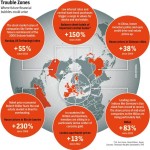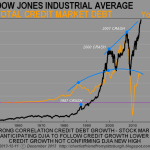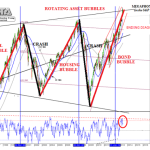We Could Easily Have A Major Stock Market Crash Much Worse …

We Could Easily Have A Major Stock Market Crash Much Worse Than 2008, Total Credit Market Debt (TCMD) Growth Is Not Confirming The New DJIA High At All
Nope, No Bubbles Anywhere
Presented with no comment (because, quite frankly, none is needed…)
http://www.zerohedge.com/news/2013-12-13/nope-no-bubbles-anywhere
About That “Bull Market Til 2016″ Call: Before You Buy the Dip, Check Out This Chart (December 13, 2013)
If credit expansion leads the stock market, the market is in trouble.
Before you buy the dip “because this Bull market will run until 2016,” please ponder this chart from our Chartist Friend From Pittsburgh of total credit and the Dow Jones Industrial Average (DJIA). Unsurprisingly, the stock market advances when credit is expanding and declines when credit growth slows.
Why is this unsurprising? Because ours is a debt-dependent consumer economy: everything from local government building projects to the purchase of vehicles to going to college requires borrowing money (i.e. credit expansion).
Source: The Dome Top Bears Have Been Given Their Stock Market Sell Signal
Here is Chartist Friend From Pittsburgh’s commentary:
Total Credit Market Debt (TCMD) growth is not confirming the new DJIA high at all.The trend of TCMD growth clearly reversed lower in 2007 by making a new all time low. The uptrend of the DJIA appears to be up since it’s recently made new all-time highs.
The point is – there’s a serious disconnect/divergence/non-confirmation going on here and in the end credit growth is the more important of the two and determines the trend because people can’t make a move nowadays without taking out a loan (house, car, student, government spending, etc.).
I would add these points:
1. Notice that credit growth is rolling over, and that its recent peak was significantly lower than the 2007 peak. In other words, despite rescuing the Too Big To Fail Banks (TBTF) to the tune of $16 trillion and the creation of $3.2 trillion that it pumped into the financial system to goose housing and stocks, the Federal Reserve’s unprecedented campaign to reflate leverage and credit only managed a weak bounce from 2007 highs in credit growth.
This is known as diminishing returns: Our Era’s Definitive Dynamic: Diminishing Returns(November 11, 2013)
The Fatal Disease of the Status Quo: Diminishing Returns (May 1, 2013)
2. In a debt-dependent consumer economy beset with declining real income for the bottom 90%, the only way to expand credit is to blow asset bubbles that boost phantom assets long enough to leverage new debt:
Why Our Consumer-Debt Dependent Economy Is Doomed December 10, 2013
Why We’re Stuck with a Bubble Economy December 9, 2013
…
And just to remind us how those bubbles ended:
http://www.oftwominds.com/blogdec13/credit-leads-stocks12-13.html
In China, Western Companies Cut Jobs as Growth Ebbs (WSJ)
Here is a Wall Street Journal article about how the Federal Reserve is experimenting with reverse repo agreements as a tool of monetary policy. “The Fed traditionally has managed short-term interest rates by shifting its benchmark federal-funds rate, an overnight intrabank rate,” but the reverse repo mechanism wouldn’t be limited to banks. In the reverse repos, counterparties would lend the Fed money — secured by Treasuries — at a rate determined directly by the Fed. (In the experimental reverse repos the Fed is currently conducting, that’s 5 basis points.)
http://www.bloomberg.com/news/2013-12-12/the-fed-doesn-t-really-trust-the-banks-either.html
Corporations Haven’t Raised This Much By Money Selling Stocks Since 2000
LONDON (Reuters) – The amount raised by U.S. stock market listings so far this year has risen 38 percent on the same period in 2012, Thomson Reuters data showed on Friday, making it the strongest year since 2000.
VIX Trader Buys $5.1 Million in Calls to Bet on 50% Increase
An investor bought $5.12 million in call options that will be profitable if the Chicago Board Options Exchange Volatility Index (VIX) jumps at least 50 percent in the next four months.
The trader purchased 40,000 April calls on the VIX with a strike price of 22 for $1.28 each, according to Trade Alert LLC. The bullish volatility bet was the biggest single block of options to change hands on U.S. exchanges, the research firm said. The VIX rose 0.8 percent to 15.54 today.
Investors are positioning for a possible jump in volatility with stocks poised for the biggest annual advance since 2003 after the Federal Reserve refrained from reducing monthly bond purchases. The central bank may begin reducing its $85 billion of monthly bond purchases at its Dec. 17-18 meeting, according to 34 percent of economists surveyed Dec. 6 by Bloomberg, up from 17 percent in a Nov. 8 poll.
Bank of America advises China default contracts to hedge debt storm
Chinese bond yields have already risen to the highest in a decade yet markets remain “complacent” about the implications
Dent, Faber, Celente, Maloney, Rogers – What Do They Say Is Coming In 2014?
–Harry Dent, author of The Great Depression Ahead: “Our best long-term and intermediate cycles suggest another slowdown and stock crash accelerating between very early 2014 and early 2015, and possibly lasting well into 2015 or even 2016. The worst economic trends due to demographics will hit between 2014 and 2019. The U.S. economy is likely to suffer a minor or major crash by early 2015 and another between late 2017 and late 2019 or early 2020 at the latest.”
–Marc Faber, editor and publisher of the Gloom, Boom & Doom Report: “You have to say that we are again in a massive financial bubble in bonds, in equities, in [other] asset prices that have gone up dramatically.”
–Gerald Celente: “Any self-respecting adult that hears McConnell, Reid, Boehner, Ryan, one after another, and buys this baloney… they deserve what they get.
And as for the international scene… the whole thing is collapsing.
That’s our forecast.
We are saying that by the second quarter of 2014, we expect the bottom to fall out… or something to divert our attention as it falls out.”
–Mike Maloney, host of Hidden Secrets of Money: “I think the crash of 2008 was just a speed bump on the way to the main event… the consequences are gonna be horrific… the rest of the decade will bring us the greatest financial calamity in history.”
–Jim Rogers: “You saw what happened in 2008-2009, which was worse than the previous economic setback because the debt was so much higher. Well now the debt is staggeringly much higher, and so the next economic problem, whenever it happens and whatever causes it, is going to be worse than in the past, because we have these unbelievable levels of debt, and unbelievable levels of money printing all over the world. Be worried and get prepared. Now it [a collapse] may not happen until 2016 or something, I have no idea when it’s going to happen, but when it comes, be careful.”
–Lindsey Williams: “There is going to be a global currency reset.”
–CLSA’s Russell Napier: “We are on the eve of a deflationary shock which will likely reduce equity valuations from very high to very low levels.”
–Oaktree Capital’s Howard Marks: “Certainly risk tolerance has been increasing of late; high returns on risky assets have encouraged more of the same; and the markets are becoming more heated. The bottom line varies from sector to sector, but I have no doubt that markets are riskier than at any other time since the depths of the crisis in late 2008 (for credit) or early 2009 (for equities), and they are becoming more so.”
–Financial editor Jeff Berwick: “If they allow interest rates to rise, it will effectively make the U.S. government bankrupt and insolvent, and it would make the U.S. government collapse. . . . They are preparing for a major societal collapse. It is obvious and it will happen, and it will be very scary and very dangerous.”
–Michael Pento, founder of Pento Portfolio Strategies: “Disappointingly, it is much more probable that the government has brought us out of the Great Recession, only to set us up for the Greater Depression, which lies just on the other side of interest rate normalization.”
–Boston University Economics Professor Laurence Kotlikoff:”Eventually somebody recognizes this and starts dumping the bonds, and interest rates go up, and inflation takes off, and were off to the races.”
–Mexican Billionaire Hugo Salinas Price: “I think we are going to see a series of bankruptcies. I think the rise in interest rates is the fatal sign which is going to ignite a derivatives crisis. This is going to bring down the derivatives system (and the financial system).
There are (over) one quadrillion dollars of derivatives and most of them are related to interest rates. The spiking of interest rates in the United States may set that off. What is going to happen in the world is eventually we are going to come to a moment where there is going to be massive bankruptcies around the globe.”
–Robert Shiller, one of the winners of the 2013 Nobel prize for economics: “I’m not sounding the alarm yet. But in many countries the stock price levels are high, and in many real estate markets prices have risen sharply…that could end badly.”
–David Stockman, former Director of the Office of Management and Budget under President Ronald Reagan: “We have a massive bubble everywhere, from Japan, to China, Europe, to the UK. As a result of this, I think world financial markets are extremely dangerous, unstable, and subject to serious trouble and dislocation in the future.”
And certainly there are already signs that the U.S. economy is slowing down as we head into the final weeks of 2013. For example, on Thursday we learned that the number of initial claims for unemployment benefits increased by 68,000 last week to a disturbingly high total of 368,000. That was the largest increase that we have seen in more than a year.
In addition, as I wrote about the other day, rail traffic is way down right now. In fact, for the week ending November 30th, U.S. rail traffic wasdown 16.3 percent from the same week one year earlier. That is a very important indicator that economic activity is getting slower.
And we continue to get more evidence that the middle class is being steadily eroded and that poverty in America is rapidly growing. For example, a survey that was just released found that requests for food assistance and the level of homelessness have both risen significantly in major U.S. cities over the past year…
A survey of 25 American cities, including many of the nation’s largest, showed yearly increases in food aid and homelessness.
The cities, located throughout 18 states, saw requests for emergency food aid rise by an average of seven percent compared with the previous period a year earlier, according to the US Conference of Mayors study, published Wednesday.
All but four cities reported an increase in demand for assistance between the period of September 2012 through August 2013.
Unfortunately, if the economic experts quoted above are correct, this is just the beginning of our problems.
The next wave of the economic collapse is rapidly approaching, and things are going to get much worse than this.
Did you already share this? No? Share it now:
Read more:
We Could Easily Have A Major Stock Market Crash Much Worse …
See which stocks are being affected by Social Media



